On the 200th birthday of a meister
- More information on Playing Anton & Being Anton
- More about Ars Electronica Futurelab & the OÖ KulturEXPO Anton Bruckner 2024
- Images via Flickr & Youtube-Clip about Playing Anton
- Press release as PDF
- Opening Event / January 31 at 6 p.m.
(Linz, January 30, 2024) Being Anton? Playing Anton! Ars Electronica is starting the Bruckner year 2024 with two specially created experience worlds. The unique sound space Being Anton and the “playful” Deep Space application Playing Anton invite you to take an unusual and immersive approach to Anton Bruckner’s compositions and sound worlds. The opening will take place on January 31, 2024 at 6 p.m.
“Anton Bruckner 2024” – the 200th anniversary of the native Austrian composer’s birthday will be duly celebrated as part of the first OÖ KulturEXPO directed by Norbert Trawöger. For 12 months there are special events for Bruckner enthusiasts and those who want to become one. Ars Electronica relies on human creativity, the immersive potential of new audio systems and virtual reality to open Bruckner’s life and works to a broader audience.
Anton Bruckner & Ars Electronica
The name Anton Bruckner stands for the art of improvisation in organ playing and for a unique musical language, for forward-looking thinking and composing. Not very melodic and full of fragments, but with energy and groove—that’s what Bruckner’s symphonic repertoire is all about. What was hardly accepted in the Romantic era of the 19th century is now celebrated as avant-garde and original. So it’s no wonder that Ars Electronica, founded in 1979 and viewed at the time by many as weird and nerdy, identified with Bruckner’s spirit from the start and launched the very first Klangwolke (sound cloud) on the banks of the Danube with Bruckner’s 8th Symphony. People put their radios in their windows and the sounds of the Bruckner Orchestra could be heard throughout Linz and Upper Austria. 45 years later, Ars Electronica is once again inviting visitors to two innovative Bruckner experiments.
Being Anton and Playing Anton are the result of a collaboration between Ars Electronica and the OÖ KulturEXPO Anton Bruckner 2024; The realization was financially supported by the state of Upper Austria and the city of Linz. Ars Electronica Futurelab was responsible for the conception and implementation in collaboration with Norbert Trawöger and Lydia Zachbauer (Head of educational outreach, OÖ KulturEXPO).
Being Anton – Immerse yourself in Bruckner’s sound worlds
Being Anton attempts to get closer to Anton Bruckner, who lived during the time of the Industrial Revolution—an era of profound upheaval—and sought to assert himself as a musician and composer. The focus is neither on his contribution to music history nor on his career path, but rather on how he might have experienced his world. A world in which industry was flourishing, steam locomotives were travelling at an incredible 60 km/h, the construction of the Suez Canal was fueling the global economy, the light bulb came onto the market and urban life was flourishing.
Based on intensive historical research and intertwined with excerpts from Bruckner’s 1st, 2nd, 7th and 8th symphonies (recorded by the Bruckner Orchestra Linz) as well as choral and organ pieces, a complex sound design was developed that takes visitors on an unconventional audio walk.
Soundscapes and patented tracking system
The dramaturgy of Being Anton is the responsibility of the audience, who are equipped with headphones. Soundscapes are controlled using a spatial tracking system (usomo, Berlin), which links sounds to position markers and puts them together in real time: What you hear depends on where you are and where you are going. The patter of rain and the clattering of horses’ hooves symbolize Bruckner’s everyday life in Vienna, diary entries read out loud provide insight into his emotional life, newspaper front pages characterize what was happening at the time, before the sound of organ music permeates the story and orchestral sounds fill the exhibition.
The individual soundscapes merge into one another, become louder and quieter, separate at certain points, but never completely disappear.
Four core themes and the organ
Being Anton revolves around the themes of industry, city, nature and sacral life. A fifth focus is on organ playing, with which Bruckner was familiar from his earliest childhood and which was to have a lasting influence on his way of writing music and lend his works their unique characteristic. In the Ars Electronica Center, acoustically it is as if you are sitting down at the organ bench: pumping noises, shoes scuffing on the floor, organ stops being changed, beams moving, the sounds of organ music playing. The soundtracks of Being Anton give the impression of being very close to Bruckner’s musical creative process, while wooden elements stylized as organ pipes show the way. Analogue information boards, photographs and original quotes about and from Bruckner complement the stroll into the 19th century.
Playing Anton – playing the first violin in the Bruckner Orchestra Linz
Playing Anton turns the Scherzo from Bruckner’s 9th Symphony—interpreted by the Bruckner Orchestra Linz—into a playful and interactive experience in Deep Space 8K. The 16×9 meter projection surface does not suggest the passive setting of a concert hall–quite the opposite. The audience is invited to approach Bruckner’s composition via 3D visualizations and learn to understand it in its individual tonal parts.
Visitors become, so to speak, musicians in the orchestra by controlling whether the cellos, the oboes or the percussion in Bruckner’s 9th should play in the foreground. In this way, the diverse possible combinations of orchestral sounds and their interaction can be tested in Deep Space 8K. This is made possible again by tracking points that are connected to the respective groups of musicians: If a visitor stands on one of the programmed areas, the image and volume of the respective group of musicians change. Since Playing Anton is a multi-user application, this means that an entire group can “play” the orchestra.
Invitation to participate
The Deep Space visitors are conducted by Markus Poschner, chief conductor of the Bruckner Orchestra Linz since 2017 and pictured life-size in Deep Space. With the baton in his hand, he turns to the players and asks them to help shape the image and sound with their movements. Anyone who is attentive can tell by the beat when the next group of musicians is called upon and experience the force with which Bruckner’s 9th is able to carry the audience along once the right balance has been found between the instruments.
With Being Anton and Playing Anton, Ars Electronica Futurelab has created two sound worlds that immediately physically capture you and offer new sensual access to Bruckner’s compositions. It is not enough to listen and observe; visitors are actively encouraged to engage in new narrative worlds and direct their experiences on their own initiative.
Outlook: Program at the Ars Electronica Center
The immersive sound space Being Anton and the Deep Space application Playing Anton will open on Wednesday, January 31, 2024, at 6 p.m. in the Ars Electronica Center and will be available from Thursday, February 1, 2024, and initially integrated in Ars Electronica exhibitions until the end of the year.
A corresponding themed weekend will take place on February 3rd and 4th, 2024, on which the tour “Playing, Being … Experiencing Anton” will celebrate its premiere and Playing Anton will be shown in Deep Space two times on both days; 11 a.m. to 11:30 a.m. and 4:30 p.m. to 5 p.m. The full program can be found here.
Tailored specifically to the interests of elementary school children (3rd and 4th grades), the new highlight tour “AnTon and Tones” starts in April and puts the sound installation Being Anton at the center of experiments with music and sound.
Statements
“The KulturEXPO will show Anton Bruckner’s work in all its facets. Upper Austria was Anton Bruckner’s homeland. He was born in Ansfelden in 1824 and was musically socialized, supported and trained at St. Florian Abbey. In Linz he developed into an organ improviser and a composer with a distinctive musical language. His 200th birthday is a welcome opportunity to jointly present Upper Austrian culture in all its diversity. We present how incredibly demanding and diverse Bruckner’s symphonic works are, which were revolutionary at the time he composed them. Bruckner’s work has influenced the music world. Bruckner had an impact far beyond his time and is still noticeable in many areas today. Bruckner is one of the few composers who was almost always at home in the countryside. We will highlight this in the 35 communities in which he worked, taught or created something and it will still be noticeable after this Bruckner year. Much of his work is linked to the state‘s tradition.”
Thomas Stelzer, Governor of Upper Austria
“The first blast furnaces are fired with coke, factories spring up, light bulbs light up the cities, natural sciences begin their triumphal march and social tensions culminate in political turning points such as the French Revolution or the American Civil War. Anton Bruckner lived in a time of upheaval that has some parallels with our present day. While many of his contemporaries took refuge in ‘Romantic’ realms, Bruckner sought and found his own path in the midst of a world that had gone out of control. Using the technologies of our time, Ars Electronica traces this artist and innovator and makes Bruckner audible and more tangible in an unusual way.”
Klaus Luger, Mayor of the city of Linz & owner representative of Ars Electronica
“Bruckner and Ars Electronica—it’s a long and coherent story. Not only did the very first sound cloud during the Ars Electronica Festival in 1979 make Bruckner’s 8th resound throughout Upper Austria; the Bruckner Orchestra Linz and Ars Electronica have been close cooperation partners for many years.
Launched in 2003 by Dennis Russell Davies and Gerfried Stocker—and further developed since 2017 with chief conductor Markus Poschner and Norbert Trawöger as artistic director —the ‘Big Concert Night’ is a highlight of every festival. How much this artistic collaboration is characterized by openness to the new and the desire to experiment is made clear, not least in the most recent projects Being Anton and Playing Anton for the Bruckner anniversary year.”
Doris Lang-Mayerhofer, City Councilor for Culture & Chair of Chair of Ars Electronica‘s Supervisory Board
“The century in which Anton Bruckner lived was a very interesting one in many respects. Many of the foundations of the knowledge that make up our world today were laid back then. With Bruckner, we are moving in the tension between digital and analog worlds, especially in our anniversary year. And this is also evident in the communication formats. While you become a Bruckner professional during the crash course on haptic materials, the educational app hublz invites you to engage interactively with Bruckner’s life and work. In Being Anton and Playing Anton there is also an exciting connection between Anton Bruckner’s work and the technology that is state of the art today. And that is no coincidence. Anton Bruckner was the piano teacher of Ludwig Boltzmann, the physicist who is known for his statistical mechanics and whose theories have inspired models of artificial intelligence. One can only speculate as to whether the musical Boltzmann was inspired by music in his research. This is undoubtedly true for the makers of immersive projects.”
Margot Nazzal, Director of Culture and Society, State of Upper Austria
“In his music, Anton Bruckner merged tradition and avant-garde in an audible simultaneity that is unprecedented in world music history. This traditional avant-garde has a tradition in this country, including in the decades-long collaboration between Ars Electronica and the Bruckner Orchestra Linz. I am incredibly pleased that, as part of the KulturEXPO at the Ars Electronica Center, with Being & Playing Anton, spaces of experience were created for people of our time to be moved by Bruckner—and you don’t even have to sit still!”
Norbert Trawöger, Artistic Director Bruckner Orchestra Linz & Artistic Director OÖ KulturEXPO Anton Bruckner 2024
“With Being Anton and Playing Anton we are trying to get a little closer to Anton Bruckner as a person. We listen into his world and his work. It is a very subjective path that gives everyone the freedom to seek and hopefully find their own approach to Bruckner. Whether the soundscapes of Being Anton or the 3D visualizations of Playing Anton — technologies of the 21st century become a bridge to a time that, like ours, was characterized by technological leaps and social tensions. I would like to thank Markus Poschner and the Bruckner Orchestra Linz, Norbert Trawöger from the OÖ KulturEXPO for the inspiring collaboration and the state of Upper Austria and the city of Linz for their financial support.”
Gerfried Stocker, Artistic director Ars Electronica

Being Anton / Ars Electronica Futurelab, Sounddesign by Julian P. Schmiederer, OÖ KulturEXPO Anton Bruckner 2024
Photo: Martin Hieslmair

Playing Anton / Ars Electronica Futurelab, Bruckner Orchester Linz, Studio Weinberg, OÖ KulturEXPO Anton Bruckner 2024
Photo: Birgit Cakir




